Detailed Business Development Plan for 'Let's Go Tanzania' Venture
VerifiedAdded on 2023/06/15
|75
|17746
|316
AI Summary
This document presents a comprehensive business plan for 'Let's Go Tanzania,' a new travel management company focused on promoting tourism and celebrating the culture and heritage of Tanzania. The plan details the business concept, including the services offered, target market, and positioning strategy. It includes a thorough literature review and industry analysis, utilizing Porter's Five Forces model. The feasibility and methodology section explores market research, product/service feasibility, organizational feasibility, and financial feasibility, including a break-even analysis. The business model is analyzed strategically, examining competitive advantages and sustainability through Porter's Value Chain and Generic Strategies. The plan concludes with an overall assessment, a business schedule, and a discussion of critical success and failure factors, determining the viability of the proposed venture. The document includes financial projections, SWOT analysis, and strategic recommendations to guide the company's development.
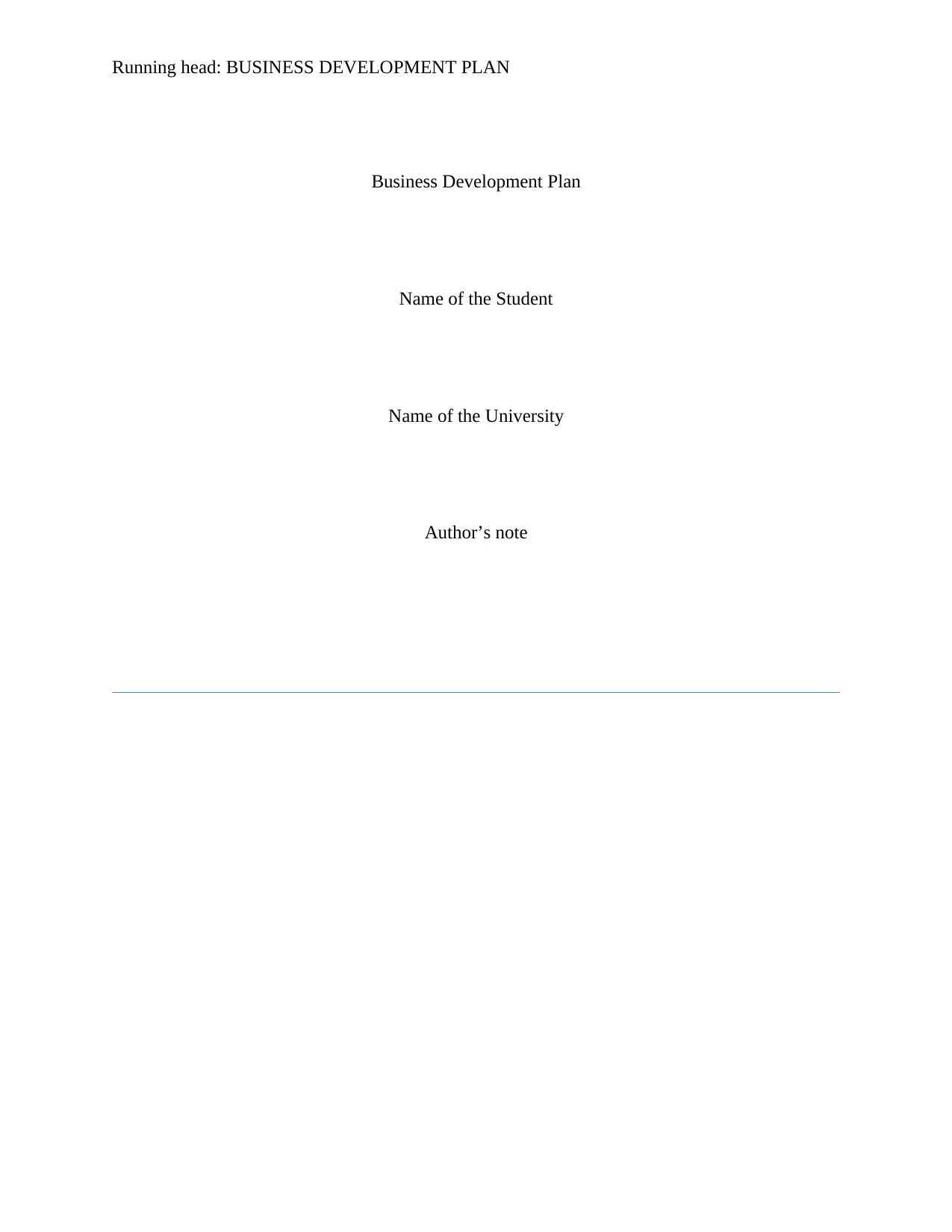
Running head: BUSINESS DEVELOPMENT PLAN
Business Development Plan
Name of the Student
Name of the University
Author’s note
Business Development Plan
Name of the Student
Name of the University
Author’s note
Paraphrase This Document
Need a fresh take? Get an instant paraphrase of this document with our AI Paraphraser
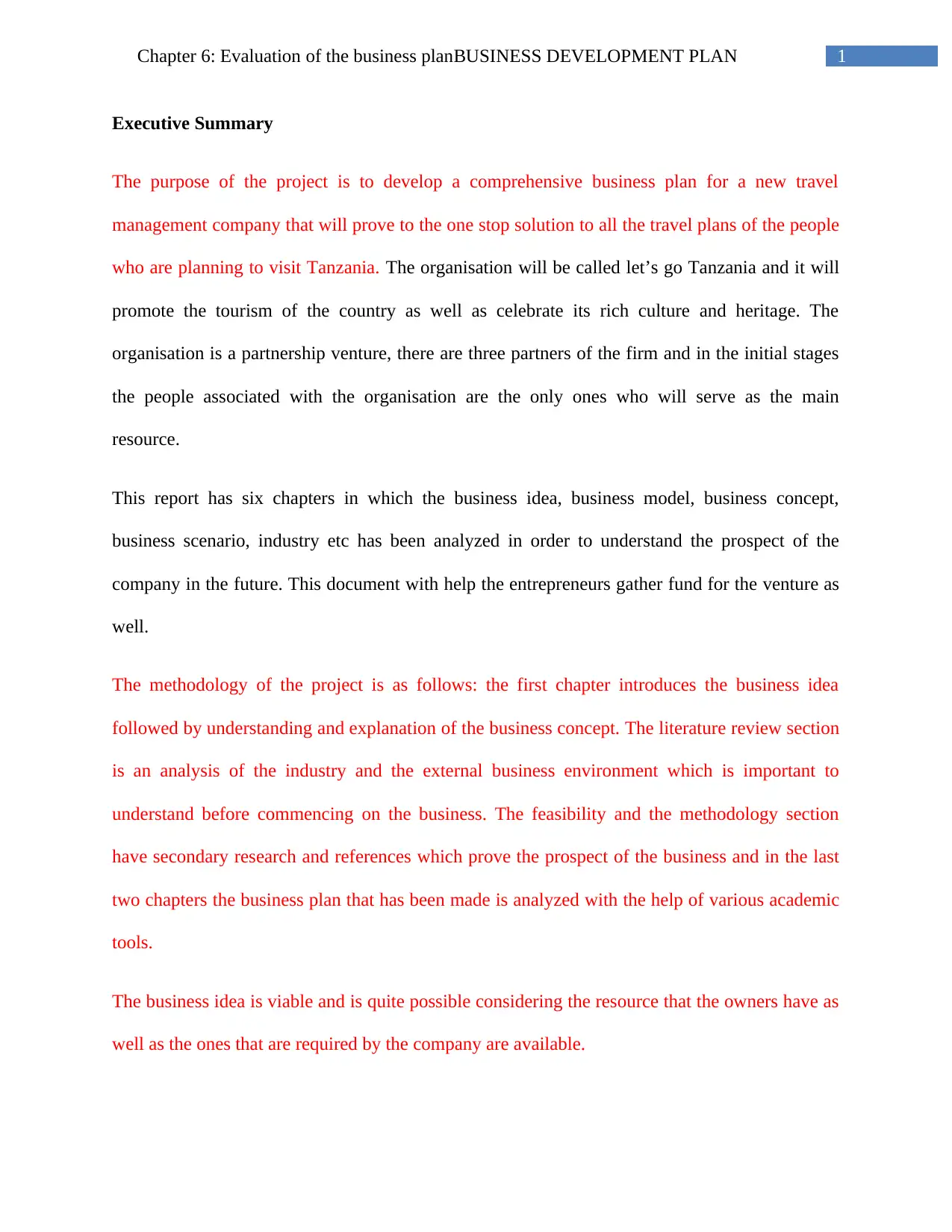
1Chapter 6: Evaluation of the business planBUSINESS DEVELOPMENT PLAN
Executive Summary
The purpose of the project is to develop a comprehensive business plan for a new travel
management company that will prove to the one stop solution to all the travel plans of the people
who are planning to visit Tanzania. The organisation will be called let’s go Tanzania and it will
promote the tourism of the country as well as celebrate its rich culture and heritage. The
organisation is a partnership venture, there are three partners of the firm and in the initial stages
the people associated with the organisation are the only ones who will serve as the main
resource.
This report has six chapters in which the business idea, business model, business concept,
business scenario, industry etc has been analyzed in order to understand the prospect of the
company in the future. This document with help the entrepreneurs gather fund for the venture as
well.
The methodology of the project is as follows: the first chapter introduces the business idea
followed by understanding and explanation of the business concept. The literature review section
is an analysis of the industry and the external business environment which is important to
understand before commencing on the business. The feasibility and the methodology section
have secondary research and references which prove the prospect of the business and in the last
two chapters the business plan that has been made is analyzed with the help of various academic
tools.
The business idea is viable and is quite possible considering the resource that the owners have as
well as the ones that are required by the company are available.
Executive Summary
The purpose of the project is to develop a comprehensive business plan for a new travel
management company that will prove to the one stop solution to all the travel plans of the people
who are planning to visit Tanzania. The organisation will be called let’s go Tanzania and it will
promote the tourism of the country as well as celebrate its rich culture and heritage. The
organisation is a partnership venture, there are three partners of the firm and in the initial stages
the people associated with the organisation are the only ones who will serve as the main
resource.
This report has six chapters in which the business idea, business model, business concept,
business scenario, industry etc has been analyzed in order to understand the prospect of the
company in the future. This document with help the entrepreneurs gather fund for the venture as
well.
The methodology of the project is as follows: the first chapter introduces the business idea
followed by understanding and explanation of the business concept. The literature review section
is an analysis of the industry and the external business environment which is important to
understand before commencing on the business. The feasibility and the methodology section
have secondary research and references which prove the prospect of the business and in the last
two chapters the business plan that has been made is analyzed with the help of various academic
tools.
The business idea is viable and is quite possible considering the resource that the owners have as
well as the ones that are required by the company are available.

2Chapter 6: Evaluation of the business planBUSINESS DEVELOPMENT PLAN
Contents
Chapter 1: Introduction....................................................................................................................6
1.1 The rational of the business opportunity...............................................................................6
Figure 1: Total contribution of travel and tourism to GDP.....................................................7
1.2 Scenario chosen.....................................................................................................................8
1.3 The Mission of the company.................................................................................................9
1.4 The Vision of the company....................................................................................................9
1.5 The Aim of the project...........................................................................................................9
1.6 The objective of the business plan.........................................................................................9
1.7 Structure of the business plan................................................................................................9
Chapter 2: The Business Concept..................................................................................................11
2.1 Introduction..........................................................................................................................11
2.2 Description of the Business Concept...................................................................................11
2.3 The product or service description......................................................................................12
2.4 The Target market................................................................................................................13
2.5 Positioning strategy.............................................................................................................14
2.6 Value Added........................................................................................................................15
2.7 Who is Involved...................................................................................................................15
2.8 The window of opportunity.................................................................................................15
Contents
Chapter 1: Introduction....................................................................................................................6
1.1 The rational of the business opportunity...............................................................................6
Figure 1: Total contribution of travel and tourism to GDP.....................................................7
1.2 Scenario chosen.....................................................................................................................8
1.3 The Mission of the company.................................................................................................9
1.4 The Vision of the company....................................................................................................9
1.5 The Aim of the project...........................................................................................................9
1.6 The objective of the business plan.........................................................................................9
1.7 Structure of the business plan................................................................................................9
Chapter 2: The Business Concept..................................................................................................11
2.1 Introduction..........................................................................................................................11
2.2 Description of the Business Concept...................................................................................11
2.3 The product or service description......................................................................................12
2.4 The Target market................................................................................................................13
2.5 Positioning strategy.............................................................................................................14
2.6 Value Added........................................................................................................................15
2.7 Who is Involved...................................................................................................................15
2.8 The window of opportunity.................................................................................................15
⊘ This is a preview!⊘
Do you want full access?
Subscribe today to unlock all pages.

Trusted by 1+ million students worldwide

3Chapter 6: Evaluation of the business planBUSINESS DEVELOPMENT PLAN
2.9 Chapter summary.................................................................................................................16
Chapter 3: Literature Review.........................................................................................................17
3.1 Introduction..........................................................................................................................17
3.2 Industry analysis..................................................................................................................17
Porter’s five force analysis........................................................................................................18
3.3 Chapter summary.................................................................................................................20
Chapter 4: Feasibility/Methodology..............................................................................................21
4.1 Introduction..........................................................................................................................21
4.2 Market Research..................................................................................................................21
4.3 Market Analysis...................................................................................................................24
4.4 Product/Service Feasibility..................................................................................................27
4.5 Organisation feasibility........................................................................................................30
4.6 Financial Feasibility.............................................................................................................31
Figure 2: Break-Even Analysis..............................................................................................34
4.7 Chapter summary.................................................................................................................35
Chapter 5: Analysis of the business model....................................................................................36
5.1 Introduction..........................................................................................................................36
5.2 Strategic analysis of the business idea.................................................................................36
Figure 3: Porter’s Value Chain model...................................................................................38
5.3 Competitive advantage and sustainability...........................................................................44
2.9 Chapter summary.................................................................................................................16
Chapter 3: Literature Review.........................................................................................................17
3.1 Introduction..........................................................................................................................17
3.2 Industry analysis..................................................................................................................17
Porter’s five force analysis........................................................................................................18
3.3 Chapter summary.................................................................................................................20
Chapter 4: Feasibility/Methodology..............................................................................................21
4.1 Introduction..........................................................................................................................21
4.2 Market Research..................................................................................................................21
4.3 Market Analysis...................................................................................................................24
4.4 Product/Service Feasibility..................................................................................................27
4.5 Organisation feasibility........................................................................................................30
4.6 Financial Feasibility.............................................................................................................31
Figure 2: Break-Even Analysis..............................................................................................34
4.7 Chapter summary.................................................................................................................35
Chapter 5: Analysis of the business model....................................................................................36
5.1 Introduction..........................................................................................................................36
5.2 Strategic analysis of the business idea.................................................................................36
Figure 3: Porter’s Value Chain model...................................................................................38
5.3 Competitive advantage and sustainability...........................................................................44
Paraphrase This Document
Need a fresh take? Get an instant paraphrase of this document with our AI Paraphraser
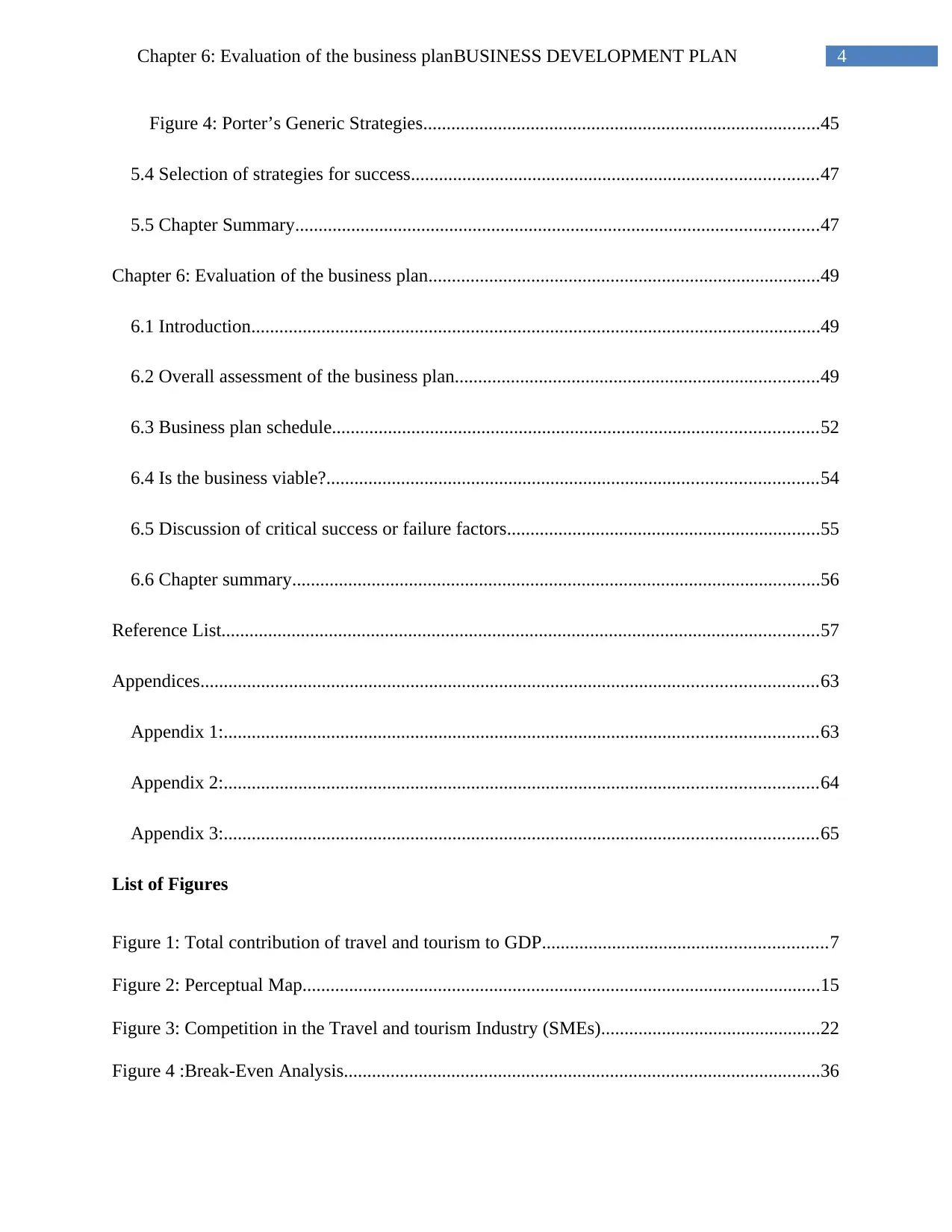
4Chapter 6: Evaluation of the business planBUSINESS DEVELOPMENT PLAN
Figure 4: Porter’s Generic Strategies.....................................................................................45
5.4 Selection of strategies for success.......................................................................................47
5.5 Chapter Summary................................................................................................................47
Chapter 6: Evaluation of the business plan....................................................................................49
6.1 Introduction..........................................................................................................................49
6.2 Overall assessment of the business plan..............................................................................49
6.3 Business plan schedule........................................................................................................52
6.4 Is the business viable?.........................................................................................................54
6.5 Discussion of critical success or failure factors...................................................................55
6.6 Chapter summary.................................................................................................................56
Reference List................................................................................................................................57
Appendices....................................................................................................................................63
Appendix 1:...............................................................................................................................63
Appendix 2:...............................................................................................................................64
Appendix 3:...............................................................................................................................65
List of Figures
Figure 1: Total contribution of travel and tourism to GDP.............................................................7
Figure 2: Perceptual Map...............................................................................................................15
Figure 3: Competition in the Travel and tourism Industry (SMEs)...............................................22
Figure 4 :Break-Even Analysis......................................................................................................36
Figure 4: Porter’s Generic Strategies.....................................................................................45
5.4 Selection of strategies for success.......................................................................................47
5.5 Chapter Summary................................................................................................................47
Chapter 6: Evaluation of the business plan....................................................................................49
6.1 Introduction..........................................................................................................................49
6.2 Overall assessment of the business plan..............................................................................49
6.3 Business plan schedule........................................................................................................52
6.4 Is the business viable?.........................................................................................................54
6.5 Discussion of critical success or failure factors...................................................................55
6.6 Chapter summary.................................................................................................................56
Reference List................................................................................................................................57
Appendices....................................................................................................................................63
Appendix 1:...............................................................................................................................63
Appendix 2:...............................................................................................................................64
Appendix 3:...............................................................................................................................65
List of Figures
Figure 1: Total contribution of travel and tourism to GDP.............................................................7
Figure 2: Perceptual Map...............................................................................................................15
Figure 3: Competition in the Travel and tourism Industry (SMEs)...............................................22
Figure 4 :Break-Even Analysis......................................................................................................36

5Chapter 6: Evaluation of the business planBUSINESS DEVELOPMENT PLAN
Figure 5: Porter’s Value Chain model...........................................................................................40
Figure 6: Porter’s Generic Strategies.............................................................................................48
Figure 7: Business model Canvas..................................................................................................52
Figure 8: Gantt chart......................................................................................................................62
List of tables
Table 1: Start-Up Requirements....................................................................................................32
Table 2: SWOT Analysis...............................................................................................................44
Figure 5: Porter’s Value Chain model...........................................................................................40
Figure 6: Porter’s Generic Strategies.............................................................................................48
Figure 7: Business model Canvas..................................................................................................52
Figure 8: Gantt chart......................................................................................................................62
List of tables
Table 1: Start-Up Requirements....................................................................................................32
Table 2: SWOT Analysis...............................................................................................................44
⊘ This is a preview!⊘
Do you want full access?
Subscribe today to unlock all pages.

Trusted by 1+ million students worldwide
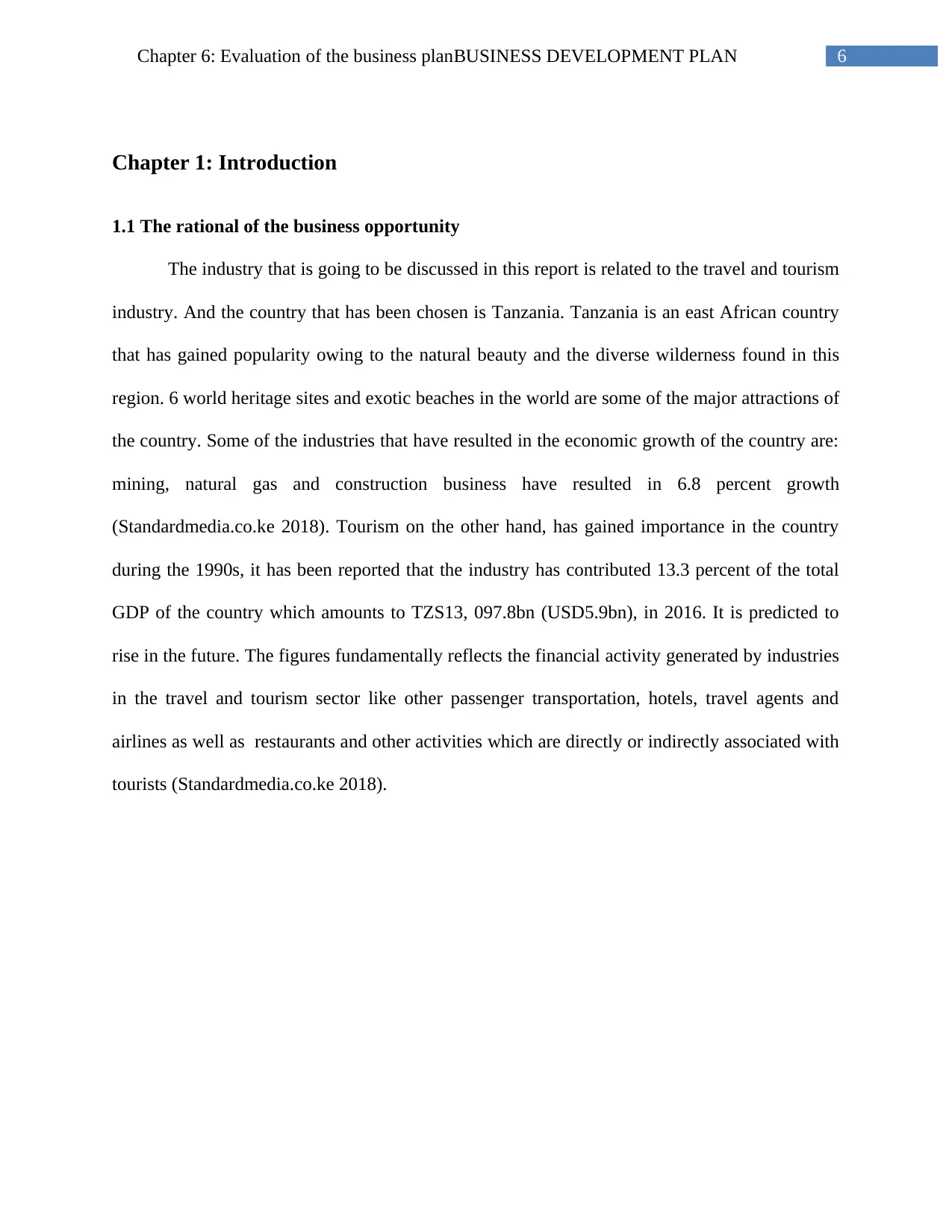
6Chapter 6: Evaluation of the business planBUSINESS DEVELOPMENT PLAN
Chapter 1: Introduction
1.1 The rational of the business opportunity
The industry that is going to be discussed in this report is related to the travel and tourism
industry. And the country that has been chosen is Tanzania. Tanzania is an east African country
that has gained popularity owing to the natural beauty and the diverse wilderness found in this
region. 6 world heritage sites and exotic beaches in the world are some of the major attractions of
the country. Some of the industries that have resulted in the economic growth of the country are:
mining, natural gas and construction business have resulted in 6.8 percent growth
(Standardmedia.co.ke 2018). Tourism on the other hand, has gained importance in the country
during the 1990s, it has been reported that the industry has contributed 13.3 percent of the total
GDP of the country which amounts to TZS13, 097.8bn (USD5.9bn), in 2016. It is predicted to
rise in the future. The figures fundamentally reflects the financial activity generated by industries
in the travel and tourism sector like other passenger transportation, hotels, travel agents and
airlines as well as restaurants and other activities which are directly or indirectly associated with
tourists (Standardmedia.co.ke 2018).
Chapter 1: Introduction
1.1 The rational of the business opportunity
The industry that is going to be discussed in this report is related to the travel and tourism
industry. And the country that has been chosen is Tanzania. Tanzania is an east African country
that has gained popularity owing to the natural beauty and the diverse wilderness found in this
region. 6 world heritage sites and exotic beaches in the world are some of the major attractions of
the country. Some of the industries that have resulted in the economic growth of the country are:
mining, natural gas and construction business have resulted in 6.8 percent growth
(Standardmedia.co.ke 2018). Tourism on the other hand, has gained importance in the country
during the 1990s, it has been reported that the industry has contributed 13.3 percent of the total
GDP of the country which amounts to TZS13, 097.8bn (USD5.9bn), in 2016. It is predicted to
rise in the future. The figures fundamentally reflects the financial activity generated by industries
in the travel and tourism sector like other passenger transportation, hotels, travel agents and
airlines as well as restaurants and other activities which are directly or indirectly associated with
tourists (Standardmedia.co.ke 2018).
Paraphrase This Document
Need a fresh take? Get an instant paraphrase of this document with our AI Paraphraser

7Chapter 6: Evaluation of the business planBUSINESS DEVELOPMENT PLAN
Figure 1: Total contribution of travel and tourism to GDP
Source: (Wttc.org 2018)
Therefore, it can be said that the industry is lucrative and has an opportunities for new
business enterprise. For adventure loving tourist this country offers some of the world’s greatest
safari tours. The tourism industry not only contributes to the economy of Tanzania it
significantly impacts the rate for employment as well (Wttc.org 2018). Technology has enabled
tourism industry to offer their customers with user friendly customization and features, tourists
do not go to a travel agency and plan a trip, rather such travel management websites provides a
plethora of facilities all at the same place. It is regarded as an opportunity as the tourism industry
is flourishing in Tanzania and the industries that are associated with the tourism management
industry like hotels and resorts are developing rapidly. Safaris are a major attraction of Tanzania,
Figure 1: Total contribution of travel and tourism to GDP
Source: (Wttc.org 2018)
Therefore, it can be said that the industry is lucrative and has an opportunities for new
business enterprise. For adventure loving tourist this country offers some of the world’s greatest
safari tours. The tourism industry not only contributes to the economy of Tanzania it
significantly impacts the rate for employment as well (Wttc.org 2018). Technology has enabled
tourism industry to offer their customers with user friendly customization and features, tourists
do not go to a travel agency and plan a trip, rather such travel management websites provides a
plethora of facilities all at the same place. It is regarded as an opportunity as the tourism industry
is flourishing in Tanzania and the industries that are associated with the tourism management
industry like hotels and resorts are developing rapidly. Safaris are a major attraction of Tanzania,
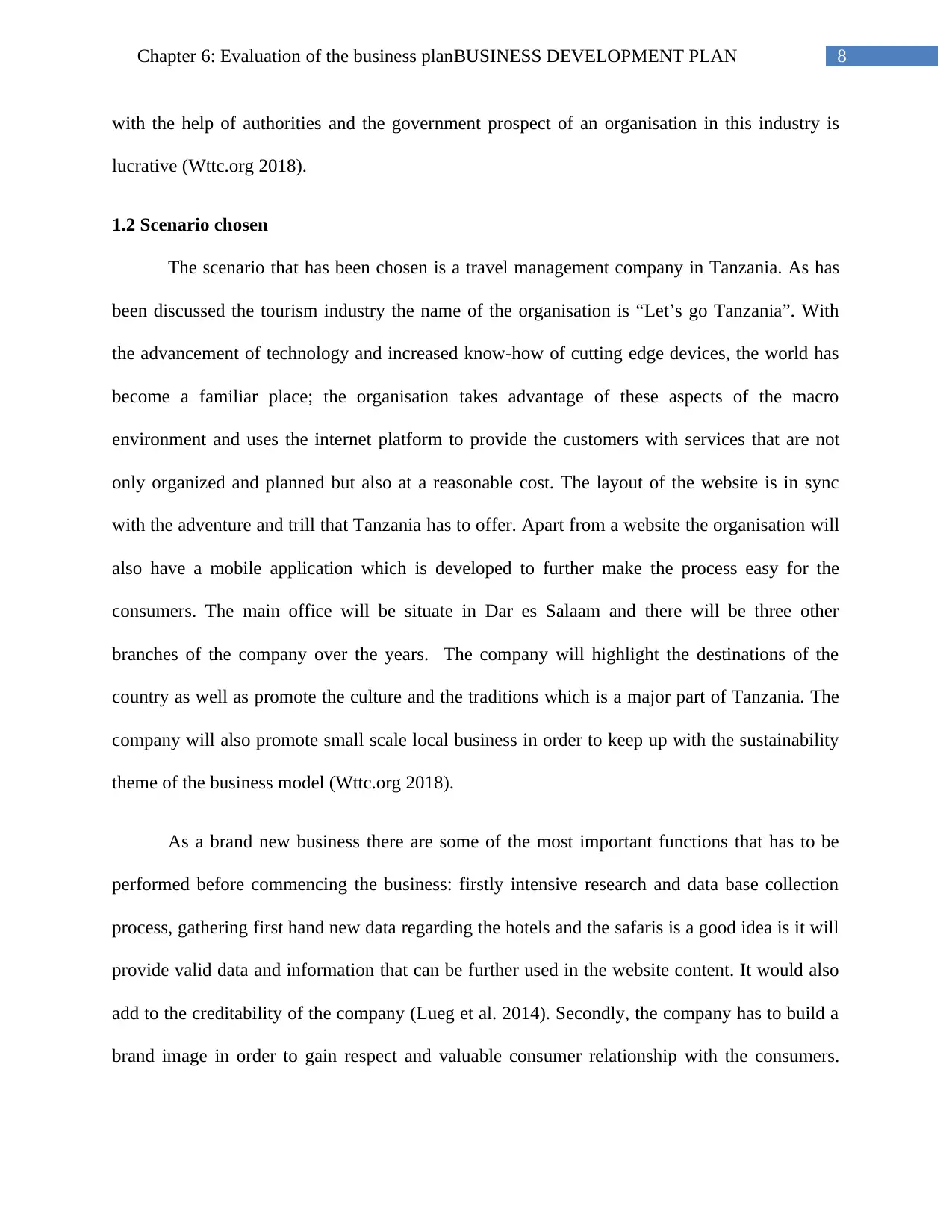
8Chapter 6: Evaluation of the business planBUSINESS DEVELOPMENT PLAN
with the help of authorities and the government prospect of an organisation in this industry is
lucrative (Wttc.org 2018).
1.2 Scenario chosen
The scenario that has been chosen is a travel management company in Tanzania. As has
been discussed the tourism industry the name of the organisation is “Let’s go Tanzania”. With
the advancement of technology and increased know-how of cutting edge devices, the world has
become a familiar place; the organisation takes advantage of these aspects of the macro
environment and uses the internet platform to provide the customers with services that are not
only organized and planned but also at a reasonable cost. The layout of the website is in sync
with the adventure and trill that Tanzania has to offer. Apart from a website the organisation will
also have a mobile application which is developed to further make the process easy for the
consumers. The main office will be situate in Dar es Salaam and there will be three other
branches of the company over the years. The company will highlight the destinations of the
country as well as promote the culture and the traditions which is a major part of Tanzania. The
company will also promote small scale local business in order to keep up with the sustainability
theme of the business model (Wttc.org 2018).
As a brand new business there are some of the most important functions that has to be
performed before commencing the business: firstly intensive research and data base collection
process, gathering first hand new data regarding the hotels and the safaris is a good idea is it will
provide valid data and information that can be further used in the website content. It would also
add to the creditability of the company (Lueg et al. 2014). Secondly, the company has to build a
brand image in order to gain respect and valuable consumer relationship with the consumers.
with the help of authorities and the government prospect of an organisation in this industry is
lucrative (Wttc.org 2018).
1.2 Scenario chosen
The scenario that has been chosen is a travel management company in Tanzania. As has
been discussed the tourism industry the name of the organisation is “Let’s go Tanzania”. With
the advancement of technology and increased know-how of cutting edge devices, the world has
become a familiar place; the organisation takes advantage of these aspects of the macro
environment and uses the internet platform to provide the customers with services that are not
only organized and planned but also at a reasonable cost. The layout of the website is in sync
with the adventure and trill that Tanzania has to offer. Apart from a website the organisation will
also have a mobile application which is developed to further make the process easy for the
consumers. The main office will be situate in Dar es Salaam and there will be three other
branches of the company over the years. The company will highlight the destinations of the
country as well as promote the culture and the traditions which is a major part of Tanzania. The
company will also promote small scale local business in order to keep up with the sustainability
theme of the business model (Wttc.org 2018).
As a brand new business there are some of the most important functions that has to be
performed before commencing the business: firstly intensive research and data base collection
process, gathering first hand new data regarding the hotels and the safaris is a good idea is it will
provide valid data and information that can be further used in the website content. It would also
add to the creditability of the company (Lueg et al. 2014). Secondly, the company has to build a
brand image in order to gain respect and valuable consumer relationship with the consumers.
⊘ This is a preview!⊘
Do you want full access?
Subscribe today to unlock all pages.

Trusted by 1+ million students worldwide
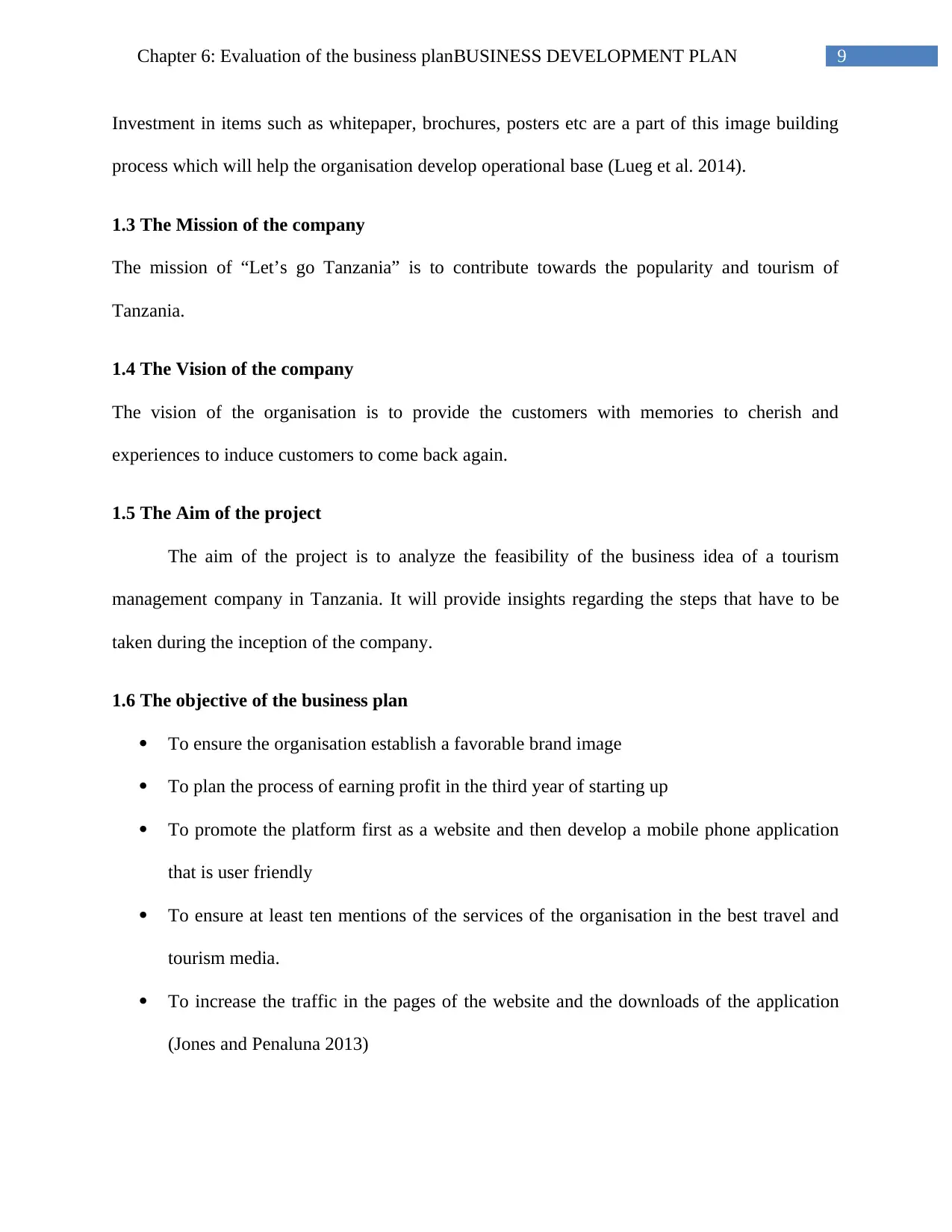
9Chapter 6: Evaluation of the business planBUSINESS DEVELOPMENT PLAN
Investment in items such as whitepaper, brochures, posters etc are a part of this image building
process which will help the organisation develop operational base (Lueg et al. 2014).
1.3 The Mission of the company
The mission of “Let’s go Tanzania” is to contribute towards the popularity and tourism of
Tanzania.
1.4 The Vision of the company
The vision of the organisation is to provide the customers with memories to cherish and
experiences to induce customers to come back again.
1.5 The Aim of the project
The aim of the project is to analyze the feasibility of the business idea of a tourism
management company in Tanzania. It will provide insights regarding the steps that have to be
taken during the inception of the company.
1.6 The objective of the business plan
To ensure the organisation establish a favorable brand image
To plan the process of earning profit in the third year of starting up
To promote the platform first as a website and then develop a mobile phone application
that is user friendly
To ensure at least ten mentions of the services of the organisation in the best travel and
tourism media.
To increase the traffic in the pages of the website and the downloads of the application
(Jones and Penaluna 2013)
Investment in items such as whitepaper, brochures, posters etc are a part of this image building
process which will help the organisation develop operational base (Lueg et al. 2014).
1.3 The Mission of the company
The mission of “Let’s go Tanzania” is to contribute towards the popularity and tourism of
Tanzania.
1.4 The Vision of the company
The vision of the organisation is to provide the customers with memories to cherish and
experiences to induce customers to come back again.
1.5 The Aim of the project
The aim of the project is to analyze the feasibility of the business idea of a tourism
management company in Tanzania. It will provide insights regarding the steps that have to be
taken during the inception of the company.
1.6 The objective of the business plan
To ensure the organisation establish a favorable brand image
To plan the process of earning profit in the third year of starting up
To promote the platform first as a website and then develop a mobile phone application
that is user friendly
To ensure at least ten mentions of the services of the organisation in the best travel and
tourism media.
To increase the traffic in the pages of the website and the downloads of the application
(Jones and Penaluna 2013)
Paraphrase This Document
Need a fresh take? Get an instant paraphrase of this document with our AI Paraphraser
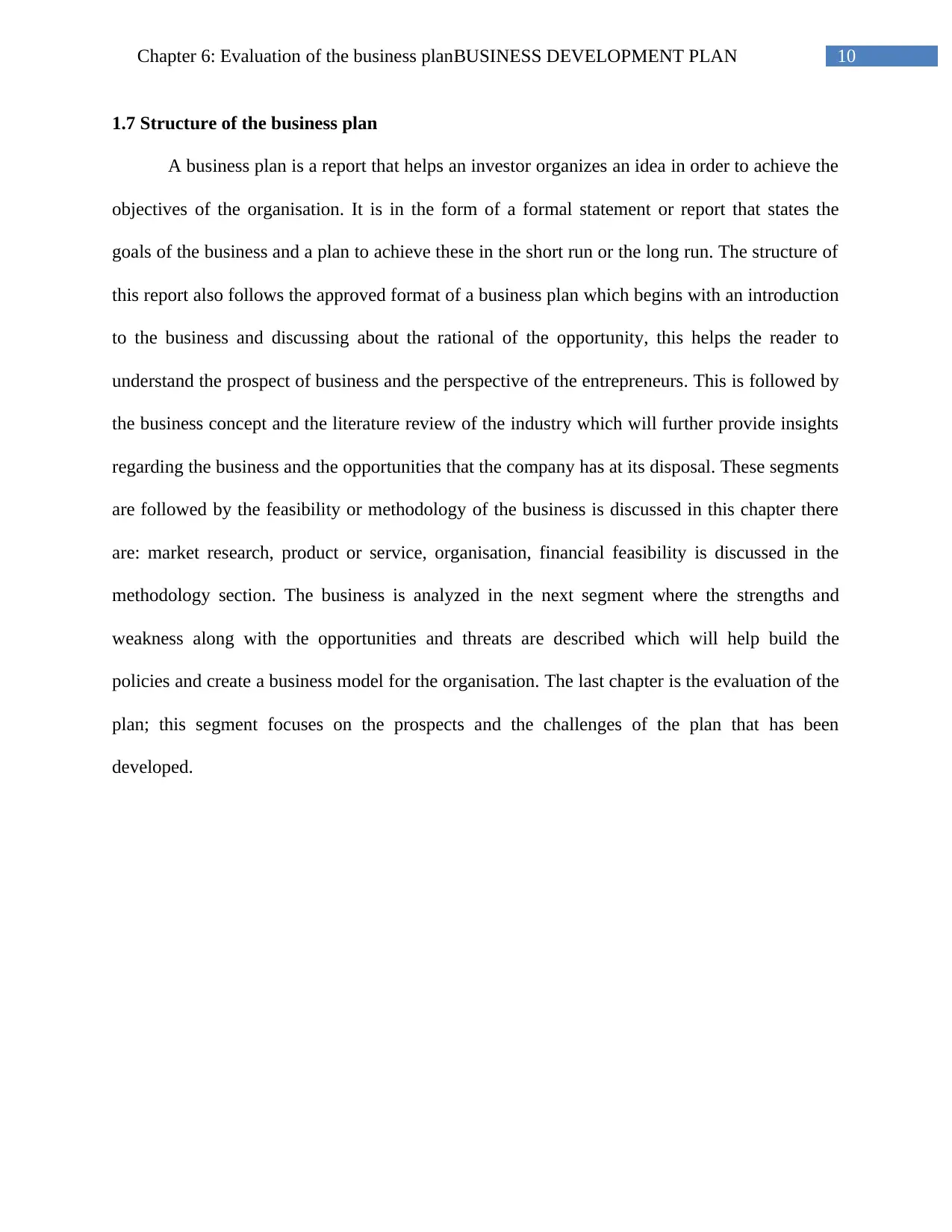
10Chapter 6: Evaluation of the business planBUSINESS DEVELOPMENT PLAN
1.7 Structure of the business plan
A business plan is a report that helps an investor organizes an idea in order to achieve the
objectives of the organisation. It is in the form of a formal statement or report that states the
goals of the business and a plan to achieve these in the short run or the long run. The structure of
this report also follows the approved format of a business plan which begins with an introduction
to the business and discussing about the rational of the opportunity, this helps the reader to
understand the prospect of business and the perspective of the entrepreneurs. This is followed by
the business concept and the literature review of the industry which will further provide insights
regarding the business and the opportunities that the company has at its disposal. These segments
are followed by the feasibility or methodology of the business is discussed in this chapter there
are: market research, product or service, organisation, financial feasibility is discussed in the
methodology section. The business is analyzed in the next segment where the strengths and
weakness along with the opportunities and threats are described which will help build the
policies and create a business model for the organisation. The last chapter is the evaluation of the
plan; this segment focuses on the prospects and the challenges of the plan that has been
developed.
1.7 Structure of the business plan
A business plan is a report that helps an investor organizes an idea in order to achieve the
objectives of the organisation. It is in the form of a formal statement or report that states the
goals of the business and a plan to achieve these in the short run or the long run. The structure of
this report also follows the approved format of a business plan which begins with an introduction
to the business and discussing about the rational of the opportunity, this helps the reader to
understand the prospect of business and the perspective of the entrepreneurs. This is followed by
the business concept and the literature review of the industry which will further provide insights
regarding the business and the opportunities that the company has at its disposal. These segments
are followed by the feasibility or methodology of the business is discussed in this chapter there
are: market research, product or service, organisation, financial feasibility is discussed in the
methodology section. The business is analyzed in the next segment where the strengths and
weakness along with the opportunities and threats are described which will help build the
policies and create a business model for the organisation. The last chapter is the evaluation of the
plan; this segment focuses on the prospects and the challenges of the plan that has been
developed.
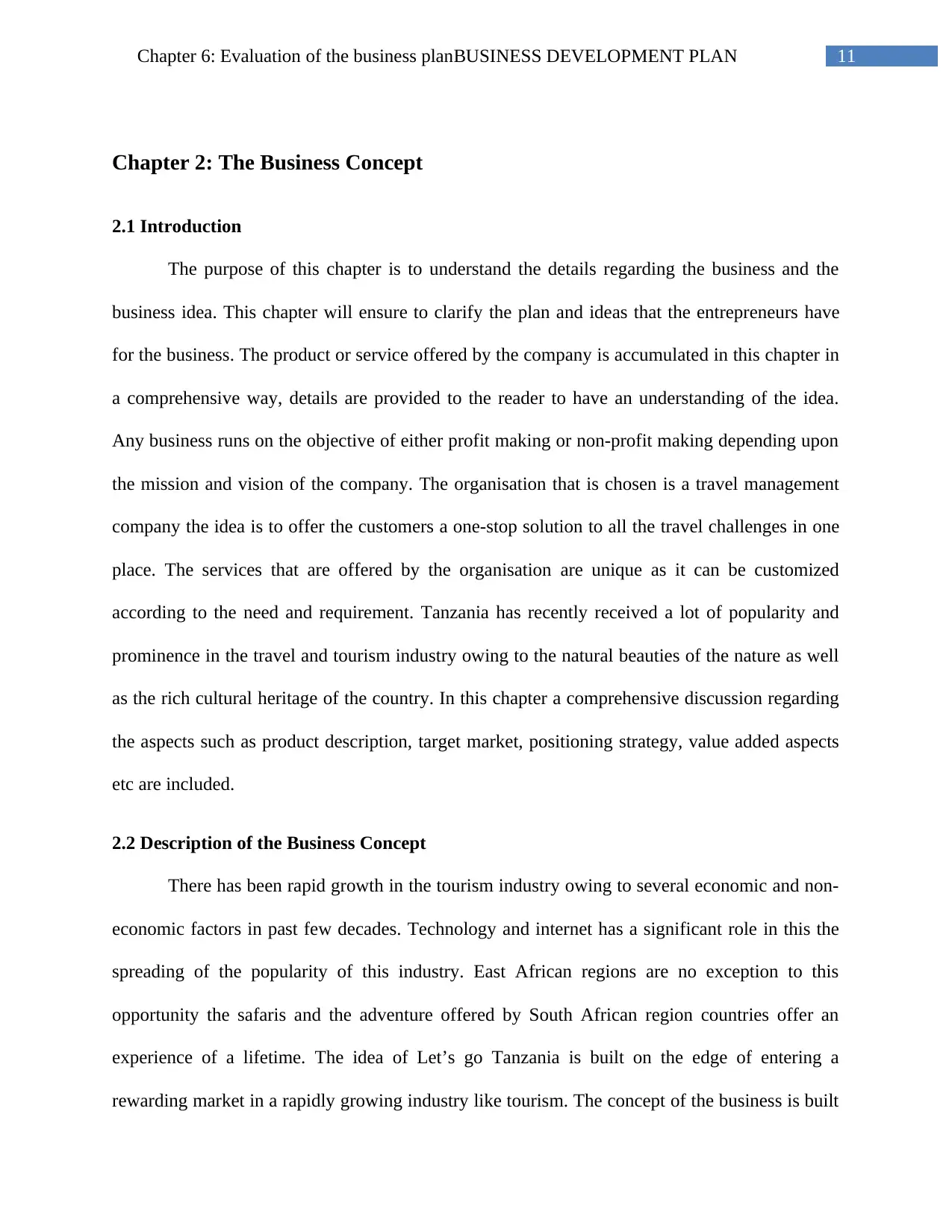
11Chapter 6: Evaluation of the business planBUSINESS DEVELOPMENT PLAN
Chapter 2: The Business Concept
2.1 Introduction
The purpose of this chapter is to understand the details regarding the business and the
business idea. This chapter will ensure to clarify the plan and ideas that the entrepreneurs have
for the business. The product or service offered by the company is accumulated in this chapter in
a comprehensive way, details are provided to the reader to have an understanding of the idea.
Any business runs on the objective of either profit making or non-profit making depending upon
the mission and vision of the company. The organisation that is chosen is a travel management
company the idea is to offer the customers a one-stop solution to all the travel challenges in one
place. The services that are offered by the organisation are unique as it can be customized
according to the need and requirement. Tanzania has recently received a lot of popularity and
prominence in the travel and tourism industry owing to the natural beauties of the nature as well
as the rich cultural heritage of the country. In this chapter a comprehensive discussion regarding
the aspects such as product description, target market, positioning strategy, value added aspects
etc are included.
2.2 Description of the Business Concept
There has been rapid growth in the tourism industry owing to several economic and non-
economic factors in past few decades. Technology and internet has a significant role in this the
spreading of the popularity of this industry. East African regions are no exception to this
opportunity the safaris and the adventure offered by South African region countries offer an
experience of a lifetime. The idea of Let’s go Tanzania is built on the edge of entering a
rewarding market in a rapidly growing industry like tourism. The concept of the business is built
Chapter 2: The Business Concept
2.1 Introduction
The purpose of this chapter is to understand the details regarding the business and the
business idea. This chapter will ensure to clarify the plan and ideas that the entrepreneurs have
for the business. The product or service offered by the company is accumulated in this chapter in
a comprehensive way, details are provided to the reader to have an understanding of the idea.
Any business runs on the objective of either profit making or non-profit making depending upon
the mission and vision of the company. The organisation that is chosen is a travel management
company the idea is to offer the customers a one-stop solution to all the travel challenges in one
place. The services that are offered by the organisation are unique as it can be customized
according to the need and requirement. Tanzania has recently received a lot of popularity and
prominence in the travel and tourism industry owing to the natural beauties of the nature as well
as the rich cultural heritage of the country. In this chapter a comprehensive discussion regarding
the aspects such as product description, target market, positioning strategy, value added aspects
etc are included.
2.2 Description of the Business Concept
There has been rapid growth in the tourism industry owing to several economic and non-
economic factors in past few decades. Technology and internet has a significant role in this the
spreading of the popularity of this industry. East African regions are no exception to this
opportunity the safaris and the adventure offered by South African region countries offer an
experience of a lifetime. The idea of Let’s go Tanzania is built on the edge of entering a
rewarding market in a rapidly growing industry like tourism. The concept of the business is built
⊘ This is a preview!⊘
Do you want full access?
Subscribe today to unlock all pages.

Trusted by 1+ million students worldwide
1 out of 75
Related Documents
Your All-in-One AI-Powered Toolkit for Academic Success.
+13062052269
info@desklib.com
Available 24*7 on WhatsApp / Email
![[object Object]](/_next/static/media/star-bottom.7253800d.svg)
Unlock your academic potential
Copyright © 2020–2025 A2Z Services. All Rights Reserved. Developed and managed by ZUCOL.




